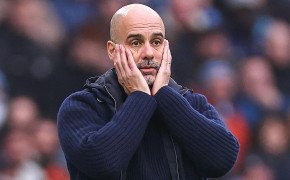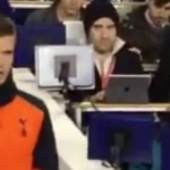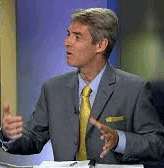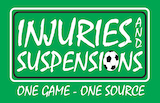It was tearful and emotional, but it was always going to be. His decision to leave the club – his club – to which he has devoted his entire professional career was never going to provoke any other type of reaction. He cited exhaustion and spoke of needing a rest, but the relentless nature of his work means he will probably return to the game next season. The simple question is: where?
Ramon Rodriguez Verdejo, better known as Monchi, has built a legacy at Sevilla, turning the perennial strugglers into arguably the most progressive club in European football. But now they must adapt to life without him, and him without them.
The former goalkeeper graduated from the youth ranks at Estadio Sanchez Pizjuan, making his professional debut in 1990 – the first of over 100 appearances for the Rojiblancos across a decade. Predominantly a substitute, he was loved and respected inside the club but went virtually unnoticed outside the Andalucian capital.
In 2000, with Sevilla freshly relegated to the Segunda division, Monchi was installed as sporting director. Viewed as a convenient cost-cutting move by a club in dire financial straits, the appointment was low-key and understated, just like his playing career.
He was tasked with two objectives by the board: develop the club’s youth system and implement a vast scouting policy both inside and outside Spain. A slick operator – he quickly picked up the nickname ‘El Lobo de Sevilla’ (‘The Wolf of Seville’) – Monchi headed the revamp of the club’s academy structure and built a worldwide network of over 700 scouts.
His methods were visionary and his success was tangible. Before his appointment, the club had won four major trophies in 110 years; in his 17-season tenure, they have added a further nine – including five Europa League titles. Sevilla have won more major European trophies since 2006 than any other club.
Domestic results drastically improved, too. In Monchi’s first campaign, Sevilla won the Segunda and are currently on course for their 16th consecutive top-half finish in La Liga. In the four years prior to his appointment, they finished bottom of La Liga twice, and fourth and seventh in the Segunda standings.
Monchi’s success has been built on buying low and selling high. The following 24 players cost Sevilla a total of €49 million in transfer fees, and were sold for a combined fee of €295m: Andrés Palop, Dani Alves, Federico Fazio, Martin Cáceres, Adriano, Ivan Rakitić, Júlio Baptista, Seydou Keita, Christian Poulsen, Luís Fabiano, Carlos Bacca, Sergio Ramos, Jesús Navas, Alberto Moreno, Luis Alberto, José Antonio Reyes, Renato, Gary Medel, Geoffrey Kondogbia, Enzo Maresca, Aleix Vidal, Diego López, Kevin Gameiro and Grzegorz Krychowiak.
The most impressive aspect of Monchi’s career has been his ability to reinvent his methods, and therefore those of the club. Initial success – both domestic and continental – came with a largely settled side of stars who were guided by coach Juande Ramos. As the side fragmented, Monchi’s position came under scrutiny and his way of working was questioned, with the signing of Arouna Kone – who, despite being the fourth-most expensive player in the club’s history, managed just two goals in 41 outings – coming in for particular criticism.
Such failures have been few and far between, however, and the sporting director swiftly adapted after that brief period of disappointment. Monchi notably improved his squad succession planning: when star striker Negredo left, he was replaced by Bacca, who was in turn succeeded by Gameiro.
Recently, too, he has shown a willingness to delve into the loan market with moves for Samir Nasri and Stevan Jovetic, who may not have any resale value but nevertheless elevate the club’s status. The highly-coveted Jorge Sampaoli was attracted last summer, when England-based players such as Nasri and Steven N’Zonzi also joined.
The youth academy has thrived under Monchi, with Sevilla Atletico – the club’s B side – now plying their trade in the second tier; unlike their Barcelona and Athletic Club counterparts, who were relegated in successive campaigns, they are thriving in the top half. This is a notable marker of Monchi’s work: after 17 years, Sevilla’s reserve side is now at the level that the first team was when he arrived.
As the 48-year-old considers his next step, all 20 Premier League clubs should be making their interest known. A mix of lucrative TV deals, overpriced signings, outdated scouting networks and poor negotiation skills have seen English outfits pay over the odds for new arrivals in recent years, while youth development is another area in need of improvement.
If fans and owners both want sustainable success, there is no-one better to provide it than Monchi. Sevilla’s five Europa League titles came during a time in which only one English side won the competition – and Chelsea’s success in 2013 was rather overshadowed by their Champions League triumph the previous year. The fact that the Rojiblancos have been such prolific trophy-gatherers while simultaneously selling their star men for sizeable profits is testament to the phenomenal work of their sporting director.
Monchi has confirmed that he met with Roma in London and, while he says he likes their plans, no contract has been signed. Clubs in both France and England have made tentative enquiries, but only one thing is for certain at this stage: after 151 signings, one promotion, nine major trophies and countless memories, Monchi will leave Sevilla this month.
Barcelona midfielder Ivan Rakitic – who captained the Andalucians to the 2014 Europa League – said the acquisition of the sporting director would be like making “10 fantastic signings” for any club. Sevilla fans may feel his departure is worth much more than that.
















